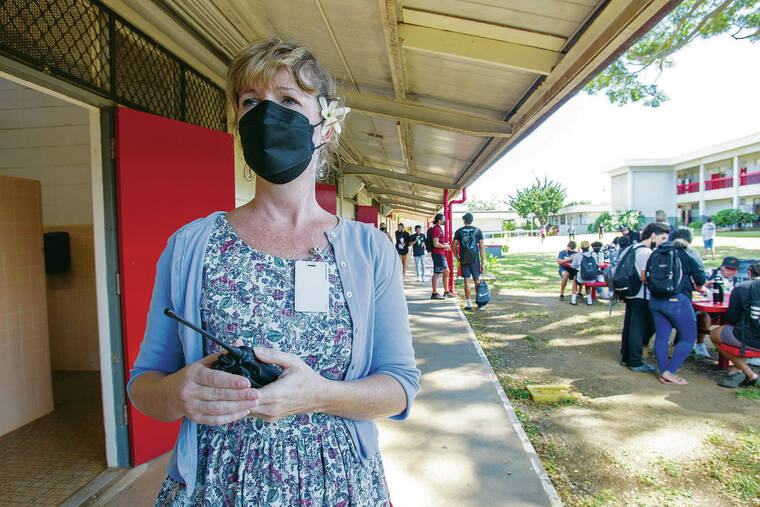
Mahalo for supporting Honolulu Star-Advertiser. Enjoy this free story!
Is a mass exodus coming of veteran Hawaii public school teachers worn out from years of working for comparatively low pay, especially through the grinding stress of the COVID-19 pandemic — or can their departure be slowed by raising their salaries?
Hawaii lawmakers are now weighing measures that would support the latter by raising thousands of teachers’ earnings to more accurately reflect their years of service.
“The pandemic has broken so many teachers. They’re pushed to the max,” said Osa Tui Jr., president of the Hawaii State Teachers Association. “Many of them have said they’re going to leave.”
Because teacher salary movements have not always been granted here in economically lean years, about 8,700 of Hawaii’s 13,500 public and charter school teachers are underpaid by $7,700 to $26,000 when their years of experience are taken into account, according to a union analysis.
It would cost the state about $94 million to close those salary gaps and provide matching employment benefits, according to a Senate Education Committee estimate.
Education officials and the union agree that retaining veteran teachers is crucial because they bring critical skills that come only with years or decades in the classroom, and because no one wants the chronic teacher shortage to worsen.
But for many educators the challenges of teaching through the chaos of the pandemic as inflation and Hawaii’s cost of living keep spiking have felt like the last straw after years they feel have lacked in adequate pay and respect.
Dana Shishido is one of the teachers considered underpaid. The 32-year teaching veteran has been stuck at the same pay class for half of her career.
The union director, who is a third grade teacher at Wheeler Elementary School, holds a bachelor’s degree and a professional diploma. Even with her credentials and continuing professional development, she only recently earned her place in Class VII, step 14, one of the highest levels on the Hawaii teachers salary schedule at approximately $84,000.
And after all this time and work, though, she still has not been elevated to the top tier, 14B, which pays about $92,000.
For the single mom, her salary doesn’t go far enough in this expensive state. Shishido had to sell her jewelry collected over 20 years to afford to send her daughter to a cheerleading tournament. Past state furloughs wiped out her savings, and once ran her bank account down to $300.
She adds that a teacher’s work includes many unpaid nights and weekends — she’s nearly nodded off driving home late from school. What’s more, when a classroom needs supplies or children arrive without having eaten breakfast, those materials and food often come out of a teacher’s pocket.
Shishido has stayed with teaching, she says, because she lives for “that moment when you see the light bulb go on: ‘Oh, I get it!’” — when a child finally comprehends an important lesson. For the teacher, she says, “That is like winning an Oscar.”
But there is no salary incentive for Shishido to stay on much longer. Add the exhausting changes in teaching that the pandemic has wrought and retirement after this school year, or switching to a better-paid job, is feeling increasingly attractive to her.
“I love the kids. I really do. I’m going to stay as long as I can. But I’m tired,” she said. “What would happen if you have a whole bunch of teachers who leave the profession? What’s going to happen to these kids?”
Keeping droves of veteran public school teachers from departing prematurely for other fields, private schools or retirement is gaining attention not just in Hawaii, but nationwide, as officials struggle to solve the teacher shortage plaguing public schools for roughly a decade and worsened by the pandemic.
The state Education Department recently reported 886 teacher vacancies, including 230 in special education.
While the HSTA has not done a formal survey to quantify how many Hawaii educators are seriously planning to depart, the concern mirrors national trends: One in every 4 teachers was considering leaving the field by the end of last school year, according to the RAND State of the U.S. Teacher survey. That was more than in a typical pre-pandemic year, and a higher rate than for employed adults nationally.
“Teaching was a stressful occupation long before the coronavirus disease 2019 (COVID-19) pandemic occurred; during the pandemic, it might have become even more stressful,” the study said. “Teachers are navigating unfamiliar technology, are balancing multiple modes of teaching, and have concerns about returning to in-person instruction. In addition, many teachers are caring for their own children while teaching.”
Almost every state is reporting a shortage of teachers, with many educators citing low pay, problematic bureaucracy, lack of respect, and fatigue from working in the pandemic among the reasons they want to leave.
Tui said union officials in Colorado told him that 67% of teachers in a recent survey indicated they were thinking about abandoning the profession.
In Hawaii, “after years of this (salary) problem not being addressed, many affected teachers have already or are beginning to qualify for retirement and see little reason to stick around,” Tui said in recent testimony to the Senate Education Committee.
“They love their students, but that is just not enough to make up for years of sacrifice,” Tui said. “Every experienced teacher we can retain is one less we need to recruit.”
In a meeting last week with the editorial board of the Honolulu Star-Advertiser, state schools interim Superintendent Keith Hayashi said he personally knows longtime teachers and administrators worn out by the pandemic who’ve said, “I’m done.” He, too, has submitted testimony to the Legislature emphasizing the importance of adjusting teacher salaries.
Unlike many other school districts across the country, Hawaii does not pay teachers based on years of experience.
Instead, the salary schedule has six classifications based on the teacher’s level of education. For example, a teacher with a bachelor’s degree typically begins in Class II. A teacher with a doctorate qualifies for Class VII. (Class I is for substitute teachers.) Teachers can rise in pay class by increasing their education.
Within each class are 12 increasing steps that teachers ascend through collective bargaining agreements. According to the current contract, over time a teacher in Class II potentially can move from $50,123 at the lowest step to $71,403 at the highest step. A teacher in Class VII can potentially go from $64,545 to $91,948.
If teachers were properly acknowledged for their service and experience, Tui said, they would reliably move up a step after every two full years of service. In theory, he said, it should take 22 years to make 11 movements and get to the top step.
The problem is that in economically lean years, such as in the last recession, step movements have not always been granted.
So thousands of teachers are stuck, or compressed, in the middle of the pay schedule. Some teachers with more than 30 years’ service aren’t at top scale.
“As a result, a teacher with decades of experience, yet not at the top of the salary schedule, sometimes makes little to no more than a teacher with significantly fewer years of experience, thus compressing very experienced teachers on the same step and rate of pay as those with significantly less experience,” states an HSTA fact sheet.
Further, it asserts, “Compression on the teacher salary schedule is a wrong that needs to be rectified if we are to stave off a mass exodus from the profession.”
Tui said many longtime teachers are saying, “If I’m not going to be recognized for my years of service, I might as well retire.”
Additionally, should the Legislature grant discretion to adjust teachers’ salaries to reflect their experience, thousands of veteran teachers already at the top salary step will have nowhere to go. So lawmakers are also considering measures to remove the cap on the salary schedule so that levels can be added.
Also among frustrated educators is Waialua High &Intermediate School teacher Victoria Pescaia. She has been held at the same pay classification for 20 of the 27 years she has been in education.
Pescaia holds a master’s degree in educational psychology and is certified in both special education for grades K-12 and career and technical education for grades 7-12. Earning her master’s degree in 2002 landed her in Class VII, for which she feels grateful.
But at this point there is no financial reason for her to stay longer at Waialua, where she serves as technology coordinator and a club adviser, or to take more professional development classes. She continues to do both, for the love of her students.
Still, like Shishido, Pescaia often contemplates how much more someone with her credentials and experience could be earning by switching jobs. Pescaia said she has former colleagues who are earning more on retirement pay and an enjoyable part-time job. “It’s a shame more of us aren’t sticking around. We invest ourselves in this profession.”
This is the first time in years that the state may be able to afford to undo “salary compression.” The pandemic stymied an attempt in 2020. Gov. David Ige has made teacher salaries a priority in this year’s budget request.
The state Board of Education voted Thursday to support fixing the salary compression problem, and the Senate Ways and Means Committee on Friday passed Senate bill 2819 to adjust salaries.
Also passing the committee was SB 2820, which would continue funding for differentials for nearly 4,000 educators in chronic shortage areas: an extra $10,000 a year for special-education teachers, $8,000 for licensed Hawaiian immersion teachers, $3,000 to $8,000 annually for teachers in hard-to-
staff schools.
Companion measures in the House also have been moving.
Will fixing salaries be enough to stop the bleeding? Hayashi said while he can’t predict every teacher’s personal decision to stay or go, “We want to be sure to recognize them for the hard work that they do. And if adjusting the compression issue is one way, and it is, then that’s something important.”
Shishido agreed. “It’s very important,” she said. “It’s going to show educators, ‘We value the work you’re doing.’”
Source: Star Ads


